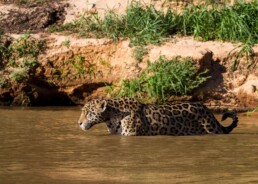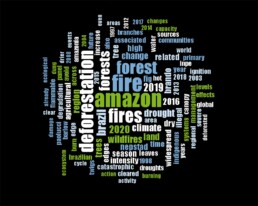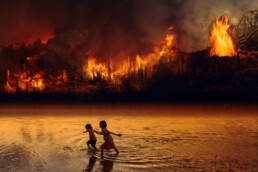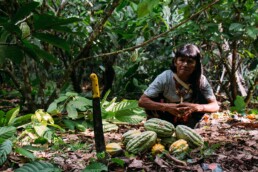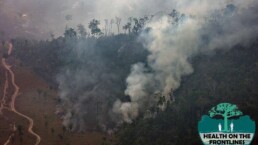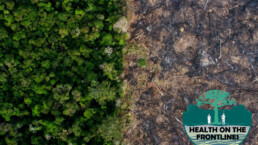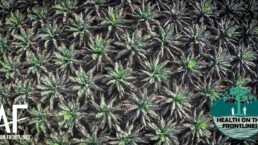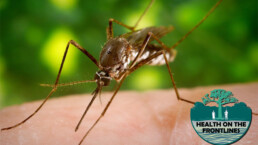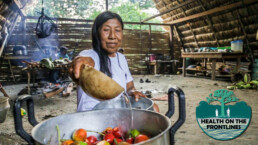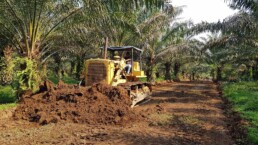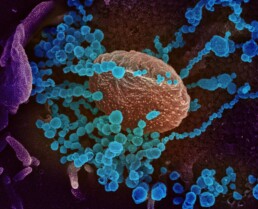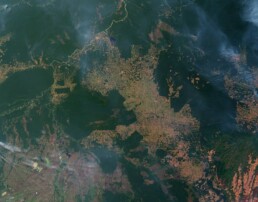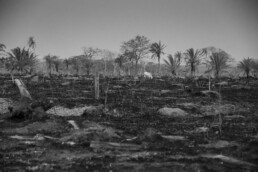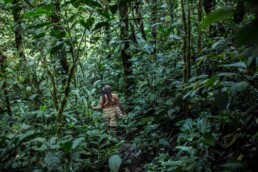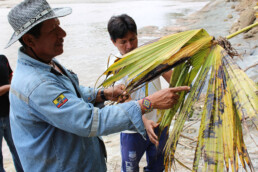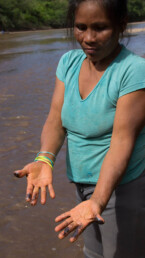Record Fires This Year Edge the Amazon Rainforest and Our Climate Closer to the Brink
From Siberia to Australia, California to the Amazon, 2020 was another record setting year for climate fueled fires – the result of rampant greenhouse gas emissions and unabated deforestation. Meanwhile, the world over, we are combatting a virus that likely emerged as a result of human encroachment into wild spaces, with vulnerable communities being the hardest hit. To add insult to injury, the oversight vacuum created by lockdown measures has led to increases in deforestation rates across the Amazon. Globally, since the start of the pandemic forest loss alerts are up 77%. The irony is that the poverty caused by broken systems and emergency responses to the virus are fueling an upsurge in the very practice – deforestation – that could generate the next pandemic and disproportionately harm indigenous land defenders, the very people who are safeguarding our future from the climate crisis and repeated pandemics.
Sketch of a Disaster Foretold
In 2019, the fires raging throughout the Amazon made headlines and pulled heartstrings across the world. This year’s fires have been far worse, but they have been eclipsed in the media by a different deforestation-generated disaster – Covid-19.
In 2019, in Brazil alone, nearly 3000 km2 (735,000 acres) of forest was felled and then burned. Add to this the additional 1,500 km2 (395,000 acres) that burned unintentionally and this is an area a little larger than the state of Rhode Island. Bolivia also had a record fire season in 2019. One of the things that was exceptional about the 2019 fire season was the number of intentionally set fires to clear land for pasture and agriculture.
Compare with 2020. Data from Brazil, dating to mid-September, suggests an area nearly four times greater has been impacted, with forest fires touching roughly 19,000 km2 (4.6 million acres) – an area between the sizes of Connecticut and New Jersey. 2020 has been drier than 2019, but still not a severe drought year. What is likely making the difference is a surveillance void in the wake of regional lockdowns to prevent the spread of Sars-CoV-2.
Unique also to 2020 is the extent of burning in the world’s largest wetland – the Pantanal, a 210,000 km2 expanse in the middle of the South American continent between Brazil, Bolivia and Paraguay, which borders the Amazon in southern Brazil. The Pantanal is home to the densest concentration of jaguars anywhere on earth. Twenty-eight percent, a little less than three times the area that has burned in California, has gone up in flames.
An article, entitled ‘Amazon wildfires: Scenes from a foreseeable disaster’ published in the scientific journal Flora concludes that increases in deforestation and climate-induced forest flammability are creating a critical situation that needs to be acted on urgently through innovation, cooperation and communication. Global efforts will prove ineffective if the Amazon’s best conservationists – Indigenous people – are left out of decision-making spaces and if their land rights are not respected and upheld.
Crimson climate, forest flammability
The main driver of these fires in the Amazon is land clearing by settlers to expand cattle and agricultural operations. Proof of this is that early in the season, in July 2020, 84% of fires burned on recently cleared land, as seen from satellite images. Compounding an already volatile situation, Covid-19 measures have led to a “wild, wild west” scenario which has allowed deforestation rates to skyrocket across the Amazon during the pandemic. A study in Colombia found that a stark increase in forest fires beginning in March 2020 corresponded with an increased presence of armed groups and decreased governmental and non-governmental forest monitoring capacity.
Fires in Brazil’s Amazon increased 13% in the first nine months of the year compared with a year ago, as the rainforest region experiences its worst fire season in a decade. This image shows the remains of what was once forest near Novo Progresso in the state of Para in the Brazilian Amazon, September 2020. Photo Marizilda Cruppe/Amazônia Real/Amazon Watch
The climate is increasingly an accomplice in this arson. The dry season in the Amazon has increased by approximately 0.6 days per year since the 1970s, partly due to deforestation and partly due to climate change. That makes A MONTH more of dry season compared to before industrialization. In that month, twigs and leaves accumulate on the ground, known as necromass, as trees shed biomass in an effort to conserve water. Over the course of the extra month, this leaf litter has a chance to get drier and drier, essentially creating a tinder box.
Meanwhile, studies are pointing at a relatively new problem in the Amazon: fragmentation and forest edges. This has been an issue in other parts of the world, but until recently the expanse of Amazonian forest was so large that the relative proportion of forest edge to intact forest was negligible. However, a recent study has shown that the number and the size of large forest plots decreased significantly from 2001 to 2017 in the Brazilian Amazon. This has an impact on fires because forest edges are drier and more vulnerable to damage from run-away fires. Another study found that post-fire annual tree mortality along forest edges was up to 90% in drought years.
“Decisive Action Now.” When the abstract of a scientific article ends this way, instead of the customary “more research is needed,” you know we’re in trouble.
In a dystopian twist, the fires themselves dry out surrounding forest making them more susceptible to fires the following year and also, in a final blow, contribute to the climate crisis which is sapping the forest of its moisture in the first place.
Climate variability, people’s vulnerability
As has been made all too clear through the global Covid-19 pandemic, disasters hit poorer people hardest, and natural disasters impact people reliant on nature, such as indigenous people, most.
Fires damage people’s property, their livelihoods and their health. In California, 10,488 Structures structures have been destroyed in this year’s fires alone. In the Amazon these figures are unknown, but a recent study found that 43% of people interviewed in an area of the Eastern Brazilian Amazon were affected by fires at least once in the past five years.
Many indigenous people throughout the world depend on forests for most of their food and building materials. Yet, in 2020, ninety percent of the Guató tribes’ land in Brazil has been destroyed, obliterating their crops and wild plants, to give just one example. Overall, there was an 87% increase in the number of fires recorded on indigenous lands in Brazil between 2018 and 2019. Fires are even raging into the land of uncontacted tribes, who depend entirely on the rainforest for their survival. Since the 2020 fire season is still upon us, it is too early to tell what the compounded impacts of increasing deforestation trends, the climate crisis and Covid-created monitoring vacuums will be.
Worrisome effects on human health come in the form of worsening air quality in the region as well. A study found that forest fires led to a 58% increase in hazardous air-borne particulate matter in the Apyterewa Indigenous lands, Eastern Brazilian Amazon, in the 2016-2019 period. Another study showed that hospitalizations among children doubled between the 2018 and 2019 fire seasons in a region of northern Brazil.
How do we get ‘Out of the Woods’
The question becomes, what do we do? Once again, scientists are not hedging: “We have never been so capable of identifying the problems haunting the Amazon as we are in 2020. Our challenge now is to act fast on the solutions, before climate change makes it much harder to solve the fire problem in the Amazon.”
Solutions to keeping destructive practices from further destroying the Amazon have to be collective because each person’s fire risk is dependent on what the neighbors do, both at the farm-level and the nation-to-nation level. This requires leadership, international coordination, high-level communication and collaboration.
Unfortunately, it seems that people in positions of power aren’t heeding the message and won’t do so unless the international community holds their feet to the fire, figuratively speaking, of course. In just one example, Bolsonaro-appointed environment minister Ricardo Salles, who was convicted of “administrative dishonesty” for deliberately altering maps in favor of a mining company, is ending environmental policies designed to keep forests standing at an alarming rate.
The recent Biden-Harris’ win in the US Presidential elections could signal a positive turning point for action on climate and the ecological emergency facing the Amazon rainforest. Biden has pledged to recommit the United States to the Paris agreement on climate change, and advocated for international cooperation to halt Amazon destruction. Indigenous peoples, such as Nemonte Nenquimo hope that Biden “will understand that the Amazon is being driven to the brink of collapse […] and have the courage to take a stand for the Earth and not side with the big industries”. Fortunately, scientists are also increasingly banding together to urge for decisive action: no more promises, no more conferences. Feet on the ground.
It is urgent that banks, customers, companies and countries do all in their power to stop feeding this carnage and encourage other viable options for the Amazon and the people who call it home. Once again, the science is clear…support for an indigenous-led, Amazon-wide halt to deforestation has never been so urgent.
COVID-19, A Stern Warning From Nature
This chronicle follows the causal arc from biodiversity loss through to increasing pandemics, putting at risk the most vulnerable sectors of society, including the very indigenous people who are some of the best custodians of biodiversity. We review evidence of the links between the destruction of the environment and disease emergence and expand the discussion to cover the potential for epidemics to arise in the Amazon.
Forlorn Warning
Researchers looking at the links between the health of ecosystems, animals and humans have foretold of a pandemic for years (Fan et al. 2019). The who, what, where and when of the current, surreal drama in which we have all unwittingly become pivotal characters in central casting were a mystery. But the stage was set on the ‘how’ decades ago.
The alarm raised by scientists mostly fell on deaf ears, until crisis hit.
The story begins with human encroachment into natural landscapes. Across the world, industrial activities such as agriculture, ranching, hydroelectric dam construction, urbanization, logging, oil extraction and mining are replacing earth’s original biomes with ones in which humans dominate. 76% of the earth’s land has already been altered, leaving only 23% to wilderness (Watson et al. 2018). This is the setting…
…now, the scenario. Land degradation provokes biodiversity loss, which in turn facilitates the propagation of diseases. Here is how it plays out. Diverse ecosystems harbor high biodiversity with significant genetic diversity. The genetic diversity of potential victims hampers the spread of disease by consistently posing unique challenges to would-be-killers (van Houte et al., 2016). If the genetic diversity of the potential target animal is high it will be harder to find a foolproof way to circumvent the immune system designed to thwart it and sneak past the cellular wall. On the other hand, if the gene pool is low, as it is when animal biodiversity is lost, pathogens quickly find solutions to dupe hosts’ immune systems and then spread rapidly throughout the relatively uniform population.
Enter HUMANS. Meanwhile, landscapes where humans dominate lead to a greater proportion of species that can tolerate the presence of humans, such as rodents and bats, as the more reclusive types slink deeper and deeper into the remaining wilderness. Exit more BIODIVERSITY. Furthermore, some of the characteristics that make these species adaptable to human environments also make them excellent hosts for infectious diseases: high mobility, longevity, and social living in colonies (Mühldorfer, 2013). As demonstrated by indigenous people across the globe, we do have the capacity to occupy spaces without dominating and degrading them: 80% of the world’s biodiversity resides inside traditional indigenous territories (Sobrevilia, 2008). But when human activities run amok and push really comes to shove, it’s Mother Nature who has the last words: Back off!
‘Whodunit’
Here’s where the plot thickens. As humans inhabit these shifting landscapes containing less and less biodiversity they come into contact with unforeseen pathogen hosts. The most common suspects are either domesticated animals or those sociable, adaptable, human tolerant characters, the rodents and bats. Original hosts develop immunity to pathogens over eons, carrying them unknowingly. Spillover events – when a pathogen adapts to use a new host – sometimes lead to permanent host shifts and are common in evolutionary history (Longdon et al. 2014). This is the making of an epidemic, because the new host has no immunity to the “novel” virus.
Coronaviruses, which are a large class of viruses normally found in rodents, bats and birds, cannot directly affect humans, and must pass through an intermediary host first. In a foreshadowing of what is coming to pass with COVID-19, SARS took center stage in 2002 when this coronavirus moved from bat to civet, a small nocturnal mammal, before becoming virulent for humans. Avian and swine flu often originate in domesticated animals. The H1N1 epidemic of 2009 has been traced to central Mexico and is believed to be the result of long-distance live pig travel allowing several strains of virus to recombine, generating a bug that could inflict harm on humans (Mena et al. 2016).

The “Spanish” flu of 1918 infected 500 million and killed between 50 and 100 million people (Sutton, 2018). The origins of this H1N1 virus are murky, but there was certainly a crossover from birds to humans, likely involving pigs as intermediary hosts (van Wijhe et al. 2018). Interestingly, it is believed that this virus was able to attain pandemic proportions despite the simplified demographics of the time due to troop movements throughout Europe and back to North America during WWI (van Wijhe et al. 2018). Few places escaped the pandemic, which reached its tendrils into the remotest regions of the world, including the Amazon (Chowell et al. 2011).
Scientists are furiously investigating how the SARS-CoV-2 virus jumped the species barrier to arrive in humans causing COVID-19. Inquiries have revealed that the original host is most certainly a bat. Molecular studies are pointing to the intermediary host being either pangolin – an endangered mammal traded illegally in wet markets of Asia – snakes or turtles, which are both legally sold at market (Liu, et al. 2020). This fact points to the primacy of clamping down on the illegal trade of wildlife and tightening up laws where they are lax, especially with respect to the sale of live animals at ‘wet’ markets.
Albeit on a lesser scale than in Asia, wet markets abound in urban centers around the Amazon (pictured above, the Belén market in the city of Iquitos, Peruvian Amazon). There, you can purchase a vast array of bush meat and exotic animals for pets. Live markets are ideal venues for humans to come into contact with potential pathogen hosts
| 1918 flu | SARS | H1N1 | MERS | COVID-19 | |
|---|---|---|---|---|---|
| “Who” | Bird->(swine?)->human | Bat->civit->human | pig->human | Bat->camel->human | Bat->?->human |
| What | Swine flu | Coronavirus | Swine flu | Coronavirus | Coronavirus |
| Where | Europe->US (?) | China | Mexico | Middle east | China |
| When | 1918 | 2002-3 | 2009 | 2012 | 2019 |
It would be all too easy to point the finger at the bat or the ‘Chinese’ in this modern-day mystery, but the real culprit is human greed and its accomplice, rampant resource extraction. Since the COVID-19 outbreak, news outlets have published countless articles describing the settings in which pandemics arise and the UN’s environment chief, Inger Andersen has emphasized that “our long-term response must tackle habitat and biodiversity loss”. Hopefully, central protagonists, such as researchers and health care professionals, can control the narrative keeping the focus on the underlying causes of the COVID-19 crisis, not easy ‘scapebats.’
Burning the Amazon: Igniting a future pandemic?
The 2019 dry season in the Amazon had the world on the edge of its seat as unfathomable acreage of pristine rainforest and previously cleared forest burned at the hands of land owners hungry for more land on which to grow cash crops, such as soy and cattle. All of this charred land is on the ancestral territories of the Amazon’s original people; however, it is unclear how much of the burned area was on land currently under indigenous jurisdiction. Contrary to elsewhere in the world, the main driver of land use change in Brazil is rising affluence, not poverty or population growth (Nava et al., 2017). In this sense, avarice is the principal motor of land clearing, while fire is the vehicle, setting in motion biodiversity loss and potentially providing the spark for a spillover event.
The vast majority of emerging zoonotic diseases in South America are vector-borne diseases, such as malaria, dengue, chikungunya, and zika, which require a vector, like a mosquito, to infect humans. COVID-19 is an ‘air-borne’ infectious disease. Vector-borne diseases are dependent on the ecological niche of the vector (temperature range, humidity, etc.) making it much less likely that they would reach pandemic scale; whereas airborne diseases travel easily from one human to the next in a wider range of habitats.

Hantaviruses, common in South America, are airborne viruses of bat origin which are known to occasionally spillover into rodents. In humans, they cause different ailments including hantavirus cardiopulmonary syndrome (HCPS). Hantavirus infections increased 800% in Brazil between 2001 and 2009 (Laerte Pinto, et al. 2014). As opposed to coronavirus, very little human-to-human transmission of hantavirus has been observed, but the few cases in which it did arise in Argentina demonstrate that it is possible.
Research along the deforestation arc of Brazil, the world’s largest deforestation frontier, has demonstrated that bat diversity is significantly lower than in the rest of the Amazon. Two species, the greater spear-nosed bat, Phyllostomus hastatus, and the gnome fruit-eating bat, Dermanura gnoma, were found to have antibodies signaling that they are hantavirus carriers (Sabino-Santos Jr, et al. 2019).
Fires further aggravate the problem because as fields and forests are lit, rodents flee flames taking shelter in dwellings, where humans come into direct contact with them (Laerte Pinto et al. 2014). Bats are also disturbed by fires. Prior to the deadly Nipah outbreak in Asia in 1997-1998, smoke from severe forest fires drove fruit eating bats from the forest into orchards, where a novel virus was forged upon recombination with pig viruses (Bonilla-Aldana et al. 2019). Climate change also contributes to diminishing biodiversity: projections show that, as it heats up and dries out, large swaths of the Amazon could shift to savannah-type landscapes, which house considerably less wildlife than tropical rainforests.
Furthermore, very preliminary data coming out of Italy is leading some scientists to believe that air pollution acts as a carrier for COVID-19. Viruses hitchhike on the particles in the air, facilitating its spread. Previous research has shown that dust storms (Chen et al., 2010) and haze (Ye et al., 2016) act as propagation mechanisms for other respiratory illnesses. If this is the case, COVID-19 or a potential hantavirus outbreak could be widely broadcast by the next Amazon fire season. The lower fauna richness in general, proliferation of human tolerant animals and proximity with settlers following deforestation through burning, would constitute significant risk factors for possible disease emergence in the Amazon. And indigenous people, who are in the firing line between settlers and the falling forest, could be the first to fall victim to an Amazonian virus making its debut.
Several recent deaths in Ecuadorian indigenous Shuar and Siekopai communities are suspected to be COVID-19 related, while in Brazil, there have been at least three COVID-19 deaths and 27 confirmed cases among indigenous people to date.
The specter of new pandemics adds one more motive in our arsenal of reasons to conserve intact forests. One way of doing this is to slow down resource extraction and agricultural expansion in a post COVID-19 era. Already, indigenous peoples in the Amazon have been demanding an immediate moratorium on any activity that includes the entrance of foreigners into indigenous territories, mining activities, logging, oil exploration and extraction, industrial agriculture, religious proselytization, or increased militarization, especially in trans-border territories under pressure from armed actors and organized crime.
Unfortunately, in some places companies and desperados are taking advantage of the dire situation to push ahead with controversial activities including mining. Meanwhile, in the Brazilian Amazon, indigenous people have witnessed an increase in illegal activities and reduced law enforcement. This lapse in vigilance could exacerbate the 2020 fire season, and as we have seen, fires in the Amazon pose a particularly volatile situation in which diseases could emerge and propagate rampantly among some of the world’s most vulnerable people. However, the COVID-19 crisis has, in other instances, temporarily paused many of these industrial activities, fugitives on the lam, and, in some places, encouraging signs of cleaner air and animals repossessing key habitats are emerging. These beacons show us that another world is possible. Indigenous land management practices are another lodestar: 40% of the world’s protected and natural spaces overlap with indigenous lands (Garnett et al. 2018), highlighting that their management strategies simultaneously allowed for their own survival and the survival or abundant biodiversity.
We still have time to contain the impact of COVID-19 on indigenous communities and avoid a catastrophic loss of life. Please donate to the Amazon Emergency Action Fund to help indigenous communities get information, supplies and medical services to protect themselves during this crisis.
Reference.
Bonilla-Aldana, D. K., J. A. Suárez, C. Franco-Paredes, S. Vilcarromero, S. Mattar, J. E. Gómez-Marín, W. E. Villamil-Gómez, J. Ruíz-Sáenz, J. A. Cardona-Ospina, S. E. Idarraga-Bedoya, J. J. García-Bustos, E. V. Jimenez-Posada and A. J. Rodríguez-Morales (2019). “Brazil burning! What is the potential impact of the Amazon wildfires on vector-borne and zoonotic emerging diseases? – A statement from an international experts meeting.” Travel Medicine and Infectious Disease 31: 101474.
Chen, P.-S., F. T. Tsai, C. K. Lin, C.-Y. Yang, C.-C. Chan, C.-Y. Young and C.-H. Lee (2010). “Ambient Influenza and Avian Influenza Virus during Dust Storm Days and Background Days.” Environmental Health Perspectives 118(9): 1211-1216.
Chowell, G., C. Viboud, L. Simonsen, M. A. Miller, J. Hurtado, G. Soto, R. Vargas, M. A. Guzman, M. Ulloa and C. V. Munayco (2011). “The 1918-1920 influenza pandemic in Peru.” Vaccine 29 Suppl 2(Suppl 2): B21-B26.
Garnett, S. T., N. D. Burgess, J. E. Fa, Á. Fernández-Llamazares, Z. Molnár, C. J. Robinson, J. E. M. Watson, K. K. Zander, B. Austin, E. S. Brondizio, N. F. Collier, T. Duncan, E. Ellis, H. Geyle, M. V. Jackson, H. Jonas, P. Malmer, B. McGowan, A. Sivongxay and I. Leiper (2018). “A spatial overview of the global importance of Indigenous lands for conservation.” Nature Sustainability 1(7): 369-374.
Fan, Y., K. Zhao, Z.-L. Shi and P. Zhou (2019). “Bat Coronaviruses in China.” Viruses 11(3).
Mühldorfer, K. (2013). “Bats and Bacterial Pathogens: A Review.” Zoonoses and Public Health 60(1): 93-103.
Laerte Pinto, V. J., H. Amani Moura, F. Dalcy de Oliveira Albuquerque and S. Vitorino Modesto dos (2014). “Twenty years of hantavirus pulmonary syndrome in Brazil: a review of epidemiological and clinical aspects.” The Journal of Infection in Developing Countries 8(02).
Liu, Z., X. Xiao, X. Wei, J. Li, J. Yang, H. Tan, J. Zhu, Q. Zhang, J. Wu and L. Liu (2020). “Composition and divergence of coronavirus spike proteins and host ACE2 receptors predict potential intermediate hosts of SARS-CoV-2.” Journal of Medical Virology n/a(n/a).
Longdon, B., M. A. Brockhurst, C. A. Russell, J. J. Welch and F. M. Jiggins (2014). “The evolution and genetics of virus host shifts.” PLoS pathogens 10(11): e1004395-e1004395.
Nava, A., J. S. Shimabukuro, A. A. Chmura and S. L. B. Luz (2017). “The Impact of Global Environmental Changes on Infectious Disease Emergence with a Focus on Risks for Brazil.” ILAR Journal 58(3): 393-400.
Mena, I., M. I. Nelson, F. Quezada-Monroy, J. Dutta, R. Cortes-Fernández, J. H. Lara-Puente, F. Castro-Peralta, L. F. Cunha, N. S. Trovão, B. Lozano-Dubernard, A. Rambaut, H. van Bakel and A. García-Sastre (2016). “Origins of the 2009 H1N1 influenza pandemic in swine in Mexico.” eLife 5: e16777.
Sabino-Santos Jr, G., F. F. Ferreira, D. J. F. da Silva, D. M. Machado, S. G. da Silva, C. S. São Bernardo, M. dos Santos Filho, T. Levi, L. T. M. Figueiredo, C. A. Peres, R. V. de Morais Bronzoni and G. R. Canale (2019). “Hantavirus antibodies among phyllostomid bats from the arc of deforestation in Southern Amazonia, Brazil.” Transboundary and Emerging Diseases: 1– 7.
Schneider, M. C., P. C. Romijn, W. Uieda, H. Tamayo, D. F. d. Silva, A. Belotto, J. B. d. Silva and L. F. Leanes (2009). “Rabies transmitted by vampire bats to humans: an emerging zoonotic disease in Latin America?” Revista Panamericana de Salud Pública 25(3): 260-269.
Sobrevila, C. (2008). The Role of Indigenous Peoples in Biodiversity Conservation: The Natural but Often Forgotten Partners. Washington, D.C. , The International Bank for Reconstruction and Development / THE WORLD BANK.
Sutton, T. C. (2018). “The Pandemic Threat of Emerging H5 and H7 Avian Influenza Viruses.” Viruses 10(9): 461.
van Houte, S., A. K. E. Ekroth, J. M. Broniewski, H. Chabas, B. Ashby, J. Bondy-Denomy, S. Gandon, M. Boots, S. Paterson, A. Buckling and E. R. Westra (2016). “The diversity-generating benefits of a prokaryotic adaptive immune system.” Nature 532(7599): 385-388.
van Wijhe, M., M. M. Ingholt, V. Andreasen and L. Simonsen (2018). “Loose Ends in the Epidemiology of the 1918 Pandemic: Explaining the Extreme Mortality Risk in Young Adults.” American Journal of Epidemiology 187(12): 2503-2510.
Watson, J. E. M., O. Venter, J. Lee, K. R. Jones, J. G. Robinson, H. P. Possingham and J. R. Allan (2018). “Protect the last of the wild: Global conservation policy must stop the disappearance of Earth’s few intact.” Nature 563: 27-30.
Ye, Q., J.-f. Fu, J.-h. Mao and S.-q. Shang (2016). “Haze is a risk factor contributing to the rapid spread of respiratory syncytial virus in children.” Environmental Science and Pollution Research 23(20): 20178-20185.
Women and Nature: Omnipresent But Invisible
Over the centuries many parallels have been drawn between women and the earth, starting with the age-old (and, for some, contested) Mother Earth, or Pachamama. More recently, the destruction of the earth for natural resource extraction has been compared with and attributed to the same underlying patriarchal forces as violence against women. Correspondingly, research has shown that environmentalism is perceived as un-masculine (Brough et al. 2016) and even that men are less likely to recycle than women because they are worried people will think they’re homosexual.
There is another parallel that deserves attention, but, due to its very nature, receives little – that of invisibility. Both women and ecosystems are often invisible in the same ways. Ironically, both are also omnipresent and so crucial. Omnipresent but invisible. Invisibility has dire consequences for the health of both women and ecosystems. This blog explores the ways that the perpetuation of this invisibility is structurally built into our institutions, societies and systems with a specific focus on consequences for Amazonian Indigenous women.
Women’s Invisibility
It will come as no surprise to readers to state that women are underrepresented in many spheres: politics, business, STEM (science, technology, engineering and math). Manuela Lavinas Picq’s (2014) in depth analysis of gender in Ecuadorian Indigenous politics points out that despite a discourse that advocates social justice and despite women’s prominence in indigenous struggles, Ecuador’s contemporary, Indigenous movement counts few women in its political leadership ranks.
Strong, female, indigenous leaders have broken through structural barriers throughout Ecuador’s history and fortunately are more and more frequent. In an early example, Tránsito Amaguaña, a Kichwa woman, helped set up the first Indigenous organization in Ecuador in the 1930s and, along with Dolores Caguango, was instrumental in the establishment of bilingual schools. In 1992, a historic march from Puyo to the capital, Quito, to fight for land rights was led by Kichwa women. More recently, in 2019, a women’s march in Brazil brought together hundreds of Indigenous and allied women to protest the destruction of the Amazon and the even more recent Indigenous mobilization against the International Monetary Fund-imposed austerity measures in Ecuador featured a women’s march. But we must not let the exceptions further blind us to the structural and systemic factors which keep women and issues important to them, for the most part, out of public purview.
Inspiring and promising exceptions exist – Here Nemonte Nenquimo, who is currently president of the Waorani political organization of Pastaza (Conconawep), leads her people in a pivotal lawsuit which recognized her people’s right to free, prior and informed consultation and suspended an auction which would have seen half-a-million acres of their pristine rainforest territory sold off to oil companies.
Nor should we fall into the trap of concluding that because women are not on the fore, they are not involved or are complacent. Women are key actors in Indigenous social justice and environmental struggles (Jenkins 2015), such as climate change. Feminist approaches to climate change are often holistic, systemic movements that address multiple environmental and justice issues at the same time (Rodriguez Acha, 2017). Further, women who are denied public tribune engage in powerful “everyday resistance” (Scott, 1985; Zanotti, 2013). Laura Zanotti (2013), in a study entitled “Resistance and the politics of negotiation: women, place and space among the Kayapó in Amazonia, Brazil” found that the everyday events and decision making processes that most villagers engage in can be as important to resistance movements as the highly visible, public acts that only a few leaders of the community participate in. Finally, western ideas of individualism, and even a feminist emphasis on autonomy and leadership, can obscure the ways in which indigenous women exert influence in their communities for the good of the collective, rather than angling for individual women’s rights (Figueroa Romero, 2018).
As the 2019 national Indigenous-led Ecuadorian mobilization highlighted “Making women visible as active participants in these struggles, and recognizing their strategic contribution, is particularly salient in the light of the increasingly violent and confrontational nature of state responses to such resistance.” (Jenkins 2015)
Tear gas, a chemical weapon, was the Ecuadorian police and military’s primary method to disperse crowds during the nationwide indigenous-led protests in October 2019
This gap between what is and what is seen exists across cultures and domains and it is also present in sectors such as sustainable forestry management (Elias et al. 2017) and health research. Karen Messing, a trailblazer of gender studies in occupational health, a field that largely considered women’s work as “light” and therefore without risk, wrote a book entitled “One-eyed Science” (1998) in which she lays bare the untold stories of women’s suffering at work and the structural issues that blind us to their suffering. More recently, Caroline Criado Perez (2019) exposes the gender data gap and reveals an invisible bias toward the male body. Her book is a startling litany of examples in which using “male” as default harms women: diagnosis of heart attacks, protective gear, and male-biased disaster warning systems. She calls this “male-unless-otherwise-indicated thinking.”
Numerous scholars and movements have also pointed out that women’s labor is widely unrecognized. They draw attention to women’s invisible role in housework, as caretaker, as food provider. To cite an Amazonian example, Susanna Hecht (2007) noted that in the Amazonian Rubber Boom context “the quotidian presence of toiling women in households was viewed as unremarkable, and so remained unremarked.” (p.324)
Women’s work is not “light” and is often repetitive, creating unique strain on the body. Here a Waorani woman carries her child and a wild boar back to the community, Yasuní National Park, Ecuadorian Amazon. Oil activity and the construction of oil roads have been severely detrimental to Waorani lands in the area
The powerful ‘#metoo’ movement has exposed the pervasiveness of violence against women. Violence most often occurs in private spaces – homes, hotel rooms, dark alleyways – out of view. The fear of reprisal and shame prevents women from calling out their aggressors, perpetuating a cycle of voluntary blindness on the part of some and fearful silence on the part of others. Research by the World Health Organization shows that the lifetime prevalence of violence against women in rural Peru is 61% (WHO, 2005). In the Ecuadorian Amazon, researcher Isabel Goicolea (2001) found that the single most commonly cited women’s health problem was ‘husband beats wife,’ cited by 84% of respondents.
Ecosystems’ invisibility
The corollaries between women’s invisibility and ecosystems’ invisibility are striking. Ecosystems do not have representatives in governments or advocates on boards of directors. Their streams burble and the wind rustles through their leaves all over the world, but there is a generalized hush about them in parliaments and board rooms in those very same places. Ecosystems are largely absent from public discourse, planning, and decision making. When and where the environment is present, it is mostly viewed as a natural resource to be exploited in production processes, not as an entity with inherent value.
In this sense, women and ecosystems can also be perversely conspicuous in the some of the same ways. While women’s bodies are objectified, landscapes are eyed for their resources. While women are prized for their reproductive services, ecosystems are valued when they are ‘productive.’
The Piatua River is one of the most beautiful rivers of the Ecuadorian Amazon. Earlier this year, the Kichwa people of Santa Clara won an important legal victory protecting the river from the construction of a hydroelectric dam, which threatened not only the river but also the Kichwa people’s way of life. Photo Courtesy Helena Gualinga
In some few instances and localities, people and systems are seeking ways in which the earth’s voice can be heard. For example, in 2008, Ecuador was the first country to enshrine the “rights of nature” in the constitution. Bolivia soon followed suit and since several countries, including New Zealand, Australia and India, have given legal rights to specific rivers (O’Donnell and Talbot-Jones, 2018). For years, the Ecuadorian edict remained quiet, until a series of court cases, including one brought to trial by the community of Sinangoe in 2018 against illegal mining, “activated” it. Nonetheless, Environmental Impact Assessments – the tool used by governments to evaluate the impacts of development projects on the health of the ecosystem – are too often done hastily, willfully turning a blind eye to the very factors that might impede the project.
Parallels also exist in the invisibility of the work that women and ecosystems carry out. Ecosystem ‘work’ is sometimes referred to as ecosystem services or the “subsidy of nature.” The Millennium Ecosystem Assessment (2005) shone a light on these services, giving them names and classifying them as provisioning services (e.g. food), regulating services (e.g. wastewater treatment), supporting services (e.g. habitat) and cultural services (e.g. mental health). Similar to women in their households, ecosystems “toil” to provide us with clean water, food, fertile soils, and materials, while this work remains patently “unremarked.” Seeing the hidden services of nature is essential for developing best practices and effective resource policies that protect ecosystems and the services they provide (Raudsepp-Hearne et al. 2010).
Lindsay Ofrias (2017), argues that the widespread contamination of the Ecuadorian Amazon by oil is an ‘invisible harm’ in that the violence that it represents is unseen even though the actual contamination is often very obvious. She also contends that this ‘invisible harm’ leads to ‘invisible opportunities’ to companies in the form of cost-cutting and even, contentiously, silencing opponents through their oppression. This ‘invisible opportunity’ has its equivalent in the gender sphere in that as women are silenced, men and their voices can benefit. Similarly, in a piece about the process of First Nations-Settler reconciliation in Canada, Hiba Zafran notes that reflexive attention to which discourses are used to frame concerns is central, as certain languages and ways of seeing “…render[…] invisible, [and do] not provide a language for the mixed intentionalities of oppressors, and possibilities within oppressive systems.” (Zafran, 2019).
The “Not in my backyard” (NIMBY) syndrome is an expression of the religation of environmental violence to out-of-the-way places, whereby toxic waste sites and open pit mines are exceedingly more likely to be located in poorer neighbourhoods and communities. The #NoDAPL (Dakota Access Pipeline) movement was precisely about a push to eclipse the potential damage of a pipeline by moving its original path from the white-dominated town, Bismark, to the Indigenous reserve, Standing Rock (Estes, 2017). Similarly, Maurice et al. (2019) recently documented local people’s testimony of oil companies using antiquated and now-illegal disposal practices that release wastes directly into the Ecuadorian Amazonian environment, clandestinely under the cover of night.
At the interface of women's and ecosystems' invisibility
Many contaminants inflicting violence on the environment literally are invisible: mercury, lead, PCBs, endocrine disruptors, all cannot be seen with the naked eye. As Michelle Murphy so aptly puts it, “…the infrastructure of chemical relations that surround and make us largely resides in the realm of the imperceptible (Murphy 2006). We might feel some of our chemical relations and the pain they cause, but the fullness of our chemical relations ends up being largely conjectural” (Murphy, 2017, p. 496). She later makes the point that, in this post-industrial era, these contaminants are also ubiquitous (Ibid, p. 497).
Donna Mergler (2012), a Canadian researcher with 50 years of experience investigating toxic hazards, makes the case that different exposure to contaminants for women and men can be obscured if data is not disaggregated along gender lines, while differential impacts can be occluded if data is not analyzed separately by sex. For example, women in the Amazon were found to be exposed to mercury (Webb et al., 2016) and hydrocarbons (Webb et al., 2017) through their relationship with water, whereas other factors were considered more important in exposure for men. If the data had not been explored separately for women and men this relationship would never have been uncovered.
Research found that women's use of water - washing clothes and dishes, bathing children and cooking - put them in contact with toxic chemicals from the petroleum industry. These aquatic environments are subject to additional sources of contamination such as pesticide run-off from palm oil monocultures
Conclusion
These multiple layers of invisibility – gender, ecosystem, race and contaminant – add up to create a virtual opaqueness in which the complexity and nuances involved seem too daunting to disentangle and depict. This parallel of invisibility is no coincidence. As Sharlene Mollett and Caroline Faria (2013) point out, “Gender and race are a historically important coupling that shapes and is shaped by space. Take the “myth of virgin land” in former “colonies” where women, and land are posited in the colonial texts to be “discovered”, “named” and “owned” and where indigenous peoples are made invisible by male conquers.”
Pulling back the invisibility cloak shrouding women and ecosystems exposes the roots of some of the more symptomatic, societal ills. Admitting that there is a gender imbalance in negotiating tables, editorial boards, high stakes meetings, parlaments, top executives, panels, health data, and so much more is a first step to redressing this inequality. Recognizing and embracing women’s and nature’s perspectives could lead to major paradigm shifts, such as more collaborative decision making processes and laws that are conceived, built and applied with a view to conserving ecosystem health into the future.
While we should be wary of “pinkwashing,” we should celebrate the courage of women who break through structural barriers to project their voice. Women’s marches and coalitions, such as the one in August 2019 in Brazil, are so important in rendering the work and perspectives of women in the Amazon visible. It is not because the system is biased against heeding women and incorporating them into official decision making processes that they are not there carrying out crucial work in the struggle against injustice. The 2019 upheaval in Ecuador sparked by International Monetary Fund (IMF) imposed austerity measures is perhaps an illustration of a society in transition. Indigenous women were at the forefront of the protests on the streets, as many emblematic images made clear, however, when it finally came time to negotiate with the government they were conspicuously underrepresented. Interestingly, while the protests were triggered by economic factors, they quickly became about much more as Indigenous peoples began to pronounce on their territorial rights.
Let this be a rallying cry to each of us to recognize where gender enters into our lives and work and to name it. We, as a society – meaning both men and women – need to look for opportunities to amplify women’s voices, from youth to elders, multiplying the occasions for women to lead, express themselves and take action.
References
Brough, A. R., J. E. B. Wilkie, J. Ma, M. S. Isaac and D. Gal (2016). “Is Eco-Friendly Unmanly? The Green-Feminine Stereotype and Its Effect on Sustainable Consumption.” Journal of Consumer Research 43(4): 567-582
Criado Perez, C. (2019). Invisible Women: Data Bias in a World Designed for Men, Harry N. Abram.
Elias, M., R. Jalonen, M. Fernandez and A. Grosse (2017). “Gender-responsive participatory research for social learning and sustainable forest management.” Forests, Trees and Livelihoods 26(1): 1-12.
Estes, N. (2017). “Fighting for our lives: #NoDAPL in Historical Context.” Wicazo Sa Review, 32(2), 115.
Figueroa Romero, D. (2018). “Mujeres Indígenas del Ecuador: la larga marcha por el empoderamiento y la formación de liderazgos.” Canadian Journal of Latin American and Caribbean Studies / Revue canadienne des études latino-américaines et caraïbes 43(2): 253-276.
Goicolea, I. (2001). “Exploring women’s needs in an Amazon region of Ecuador.” Reproductive Health Matters 9(17): 193-202.
Hecht, S. B. (2007). “Factories, Forests, Fields and Family: Gender and Neoliberalism in Extractive Reserves.” Journal of Agrarian Change 7(3): 316-347.
Jenkins, K. (2015). “Unearthing women’s anti-mining activism in the Andes: Pachamama and the “Mad Old Women”.” Antipode 47(2): 442-460.
Maurice, L., F. López, S. Becerra, H. Jamhoury, K. Le Menach, M.-H. Dévier, H. Budzinski, J. Prunier, G. Juteau-Martineau, V. Ochoa-Herrera, D. Quiroga and E. Schreck (2019). “Drinking water quality in areas impacted by oil activities in Ecuador: Associated health risks and social perception of human exposure.” Science of The Total Environment 690: 1203-1217.
Mergler, D. (2012). “Neurotoxic exposures and effects: Gender and sex matter! Hänninen Lecture 2011.” NeuroToxicology 33(4): 644-651.
Messing, K. (1998). One-eyed Science: Occupational Health and Women Workers, Temple University Press.
Millennium Ecosystem Assessment. (2005). Ecosystems and human well-being: synthesis. Washington, DC.
Mollett, S. and C. Faria (2013). “Messing with gender in feminist political ecology.” Geoforum 45: 116-125.
Murphy, M. (2006). Sick Building Syndrome and the Problem of Uncertainty: Environmental Politics, Technoscience, and Women Workers. Durham, N.C., Duke University Press.
Murphy, Michelle. 2017. “Alterlife and Decolonial Chemical Relations.” Cultural Anthropology 32(4): 494-503. https://doi.org/10.14506/ca32.4.02.
O’Donnell, E. L. and J. Talbot-Jones (2018). “Creating legal rights for rivers: lessons from Australia, New Zealand, and India.” Ecology and Society 23(1).
Ofrias, L. (2017). “Invisible harms, invisible profits: a theory of the incentive to contaminate.” Culture, Theory and Critique 58(4): 435-456.
Raudsepp-Hearne, C., G. D. Peterson and E. M. Bennett (2010). “Ecosystem service bundles for analyzing tradeoffs in diverse landscapes.” Proceedings of the National Academy of Sciences 107(11): 5242-5247.
Rodriguez Acha, M. A. (2017). “We have to wake up, humankind! Women’s struggles for survival and climate and environmental justice.” Development 60(1-2)((1-2)): 32-39.
Scott, J. (1985). Weapons of the weak: Everyday forms of peasant resistance. New Haven, CT, Yale University Press.
Webb, J., O. T. Coomes, D. Mergler and N. Ross (2016). “Mercury Concentrations in Urine of Amerindian Populations Near Oil Fields in the Peruvian and Ecuadorian Amazon.” Environmental Research 151: 344-350.
Webb, J., O. T. Coomes, D. Mergler and N. A. Ross (2017). “Levels of 1-hydroxypyrene in urine of people living in an oil producing region of the Andean Amazon (Ecuador and Peru).” International Archives of Occupational and Environmental Health 91(1): 105-115.
WHO (World Health Organization) (2005). WHO multi-country study on women’s health and domestic violence against women: summary report of initial results on prevalence, health outcomes and women’s responses. Geneva, World Health Organization.
Zafran, H. (2019). Ecopoetics and unbelonging: Shaping ground within Indigenous partnerships. [Workshop presentation]. Paper presented at the Advanced Study Institute in Cultural Psychiatry: Cultural Poetics of Illness and Healing: Embodiment, Enactment and the Politics of Experience, Montréal, QC
Zanotti, L. (2013). “Resistance and the politics of negotiation: women, place and space among the Kayapó in Amazonia, Brazil.” Gender, Place & Culture 20(3): 346-362.
List of Chronicles in our Health on the Frontlines series:
Tapping into the Amazon’s Rain

For many of you who are reading this Chronicle, access to potable water, directly into your home, is a given. For most people in the world, though, this simply is not the case. In fact, according to the United Nations billions of people live without access to safe water. Billions. Among them are the indigenous communities of the Ecuadorian Amazonian rainforest where, despite the fact that water abounds, the rivers and streams have been nearly ubiquitously contaminated by oil, rendering the once pristine waters undrinkable. At the same time, ballooning population combined with inadequate sanitation has led to a rise in parasites carried by water.
From 2012 to 2018, Amazon Frontlines and its partner organization Ceibo Alliance provided domestic rainwater harvesting systems to 1164 households in 78 communities of the Northeastern Ecuadorian Amazon benefiting over 6000 people living downriver from the oil fields. In this Chronicle, we will learn more about the water-related health problems that indigenous people in the Amazon face and how domestic rainwater harvesting systems are helping.
Tainting the Amazon's surface water
In the period from 2005 to 2015 alone, oil companies released over 350,000 barrels of crude oil into the rivers, streams and soils of the Ecuadorian Amazon, amounting to an average of 4000 barrels of a toxic chemical mix, including heavy metals and polycyclic aromatic hydrocarbons, released every day into the environment. Some hydrocarbons are known carcinogens (IARC, 2015). A study in an oil-producing region of Peru examined nearly 3000 river water samples and found that a significant number of them did not meet Peruvian water quality standards for a variety of metals. The authors conclude, “that spillage of produced water in Peruvian Amazon rivers placed at risk indigenous population and wildlife during several decades. Furthermore, the impact of such activities in the headwaters of the Amazon extended well beyond the boundaries of oil concessions and national borders, which should be taken into consideration when evaluating large scale anthropogenic impacts in the Amazon” (Yusta-García 2017, abstract).
Co-founders of the Ceibo Alliance show evidence of oil contamination in the northern Ecuadorian Amazon. From left to right: Alicia Salazar of the Siona nation, Nemonte Nenquimo of the Waorani nation, and Flor Tangoy of the Siona nation.
Concurrently, African palm plantations have led to the deforestation of an equivalent of 100 000 soccer fields and the use of a large quantity of pesticides and fertilizers, some of which end up in the local waterways. Some pesticides are considered probable carcinogens (IARC, 2015).
Over the past half-century, the Ecuadorian Amazon has been crisscrossed by more than 9500 km of roads – or 1.5 times the Earth’s radius – built to connect the more than 3430 oil wells to market via pipeline. The construction of a proposed road in a remote region of the Peruvian Amazon was found to have disproportionately negative impacts on the drinking water quality (sediment retention and nitrogen and phosphorus regulation) of nearby indigenous communities (Mandel et al. 2015).
Access roads entice colonists to set up small farms, resulting in the deforestation of vast tracts of land. Amazonian soils contain large amounts of naturally occurring mercury, accumulated there over centuries of nearby volcanic activity (Mainville et al. 2006). Mercury exists in the soils in a harmless form, but once soils erode into waterways following deforestation, the mercury is converted into a toxic form, easily entering the aquatic food chain and humans via fish consumption (Webb et al. 2004). Illegal gold mining, booming in certain areas of the Amazon, can also be an important source of mercury to aquatic ecosystems (Akagi et al., 1995).
From Pristine to Parasite-infested
Sipping your chlorinated water, fresh from the tap, you might think, “Who would drink straight from the river?” Yet, for millennia, this was the main source of water in the Amazon and it supported thriving civilizations. However, nowadays, the water is teeming with harmful microscopic life that your eyes can’t see but that your intestines detect. Studies show that the current high parasite levels are not the baseline for Amazonian waterways.
Several early studies conducted in the 1980s, just as the population of the Ecuadorian Amazon was exploding, show that the indigenous people, who had no other source of water than the same streams and rivers that their ancestors drank from, had relatively low parasite levels. “Before sustained contact, the Huaorani had practically no intestinal parasites due to drinking from feeder streams with headwaters rarely visited by outsiders; however, within 3 years of contact their parasite loads were nearly equal to those of neighboring groups” (Davis and Yost, 1983 in Houck et al., 2013).
Benefice et al. (1990) showed that parasitic infestation rates among settlers were significantly higher than in the Siona-Secoya communities and attributed this partly to the readily available and good quality water running through indigenous communities.
Waorani women in their ancestral territory, Pastaza Province, Ecuadorian Amazon
A recent study conducted in Bolivia found that the Tsimane’ people appear to adapt to poor water quality by eating more fruit (Rosinger and Tanner, 2015). They found that 50% of their total water intake came from fruit and that each percent increase in water consumed from food was associated with a decrease in gastrointestinal illness. “Both total water intake and percentage of water from foods were higher than averages in industrialized countries. These findings suggest that people without access to clean water may rely on water-rich foods as a dietary adaptation to reduce pathogen exposures” (Rosinger and Tanner, 2015; abstract). Unfortunately, some of the same processes that are leading to deteriorating water quality are also reducing people’s access to flourishing forests and their succulent produce.
Amazonian ecosystems had their own mechanisms for keeping parasite levels low. The problem has arisen recently primarily because of swelling population levels and inadequate sanitation. The ecosystem has quite simply become overloaded with feces. At the same time, current land-use practices are diminishing the ecosystem’s ability to rid water of existing parasites. Healthy forests, intact soils and rich decomposer biodiversity can provide physical barriers to substances that hold high levels of parasites from getting into waterways. Without them, parasites can get the upper hand. Additionally, a recent paper has shown that coliforms, and potentially other harmful water-borne pathogens, proliferate in the presence of hydrocarbons (Khanafer et al. 2017).
Climate change is leading to flooding in certain regions and drought in others. Both affect water security. In Bolivia, it was found that incidence of diarrhea related to pathogens in the the water roughly doubled following a historic flood in 2014 (Rosinger 2017). Floods sweep away domestic animals and wildlife contaminating river water, while overflowing rivers seep into otherwise clean underground water sources.
In 2016, water, sanitation and hygiene (WSH) was responsible for 1.9% of the global burden of disease. The latest data available for Ecuador estimates the total WSH-related deaths at 88,200, or 3.9% of the deaths in 2004. In 2015, over 2 million Ecuadorians did not have access to improved water. Chronic diarrhea, especially in children, can lead to malnutrition (Buitron et al. 2004). Treatments for stomach complaints can sap scarce economic resources from families with limited revenue, forcing them to work longer hours, go without other essentials or exploit natural resources.

Provisioning Water from Rain
The United Nations named access to clean drinking water a basic human right in 2010. In that same year, 89 million people across the globe depended on rainwater as their main supply (WHO and UNICEF, 2012). Rainwater is largely free of impurities (World Health Organization, 2008). When properly installed and managed, Domestic Rainwater Harvesting (DRWH) Systems are considered inexpensive and low-tech; and vastly superior to most alternatives, such as surface water. Bearing in mind the benefits of rainwater harvesting, expanding capacity in developing countries has been set as a new World Health Organization goal (6.a) (WHO and UNICEF, 2017; p.7).
Most studies have reported levels below maximum permissible concentrations for metals, hydrocarbons and pesticides in rain-harvested water (Abbasi & Abbasi, 2011). Women in the Amazon who use surface water were found to have twice the amount of mercury and hydrocarbons in their urine as women who use rainwater (Webb et al. 2016; 2017).
Considering the abundance of rain in the Amazon and deteriorating water quality as a result of industrial extraction processes and demographic changes, Amazon Frontlines and the Ceibo Alliance, along with our partners Rainforest Fund and Saving an Angel, designed a water provisioning project based on the installation of domestic rainwater harvesting systems. Over the past seven years, the ClearWater project has provided clean and free drinking water to indigenous peoples of the Kofan, Secoya, Siona, and Waorani nations in the Ecuadorian Amazon, one of the world’s most infamous oil-related disaster areas.
In order to ensure that the 6000-plus people serviced by ClearWater’s rainwater harvesting systems were indeed benefiting from the water provided by the ClearWater project, we conducted an evaluation of water quality, integrating observations from in-depth interviews with users in the indigenous communities.
“How safe is the water? How has your life changed since you got potable water? Have you observed any changes in your health?” The Ceibo Alliance’s Scientific Advisor, Jena Webb, and Amazon Frontlines’ Monitoring Lead, Nicolas Mainville, led an investigation to find out.
Here are some of the most important findings:
· Drinking water samples had no detectable levels of polycyclic aromatic hydrocarbons (PAHs) or heavy metals such as mercury and lead.
· 86% of people reported improved digestive health (reduced diarrhea, vomiting and stomach pain) since the installation of the systems.
· 85% of systems had ideal water quality as indicated by fecal coliform levels.
· Water from alternative sources (rivers, streams and springs) had significantly lower water quality as indicated by high levels of fecal coliform.
· One hundred percent of the respondents were satisfied with the taste of the water and the functioning of their system.
The qualitative analysis showed a high level of satisfaction with the water and the systems. Comments pointed to improvements in health and workload, with the system reducing the number of hours and the effort required to collect water. This is especially crucial with respect to women’s work, health and well-being as this task most often falls to women and girls. World-wide, eight out of ten households in which water is off-premises rely on women and girls to carry out the difficult, and sometimes dangerous, task of water collection. In the water security study carried out in the Bolivian Amazon, 24% of women (compared to only 7% of men) reported having been injured in the month prior while fetching water (Rosinger 2018).
“The tanks make it easier because we have water right here. Before we had the tanks, we had to go down to the river, lug up buckets, and go back, up and down, often. We had more work. But now, no, we have the tank right at the foot of the house. I used to get tired.”- Anonymous woman interviewed as part of our evaluation on the ClearWater Domestic rainwater harvesting systems
So, now 1164 households in 78 communities of the Ecuadorian Amazon also have running water, right at their kitchen door, thanks to the ClearWater project. This water contains no chlorine, but the vast majority of it is just as clean as that coming out of the faucet in any home in a developed nation. Clean drinking water is the most fundamental of basic needs and a prerequisite for thriving and resilient communities. Our hope in conducting this project has been to contribute to these communities’ wellbeing and their capacity to defend their forest homes. Our hope in communicating about the evaluation is to build out solutions and lessons for other indigenous villages affected by oil and water of sub-standard quality on how to construct rainwater harvesting systems and maintain them. As oil companies continue to push further into the forest, this urgent work continues both here in the Ecuadorian Amazon and elsewhere.
Find out more about this powerful indigenous-led and community-based project, and join the movement for a healthy future in the Amazon.

References
Abbasi, T. and S. A. Abbasi (2011). “Sources of pollution in rooftop rainwater harvesting systems and their control.” Critical Reviews in Environmental Science and Technology 41(23): 2097-2167. https://www.tandfonline.com/doi/abs/10.1080/10643389.2010.497438
Akagi, H., O. Malm, Y. Kinjo, M. Harada, F. J. P. Branches, W. C. Pfeiffer and H. Kato (1995). “Methylmercury pollution in the Amazon, Brazil.” Science of The Total Environment 175(2): 85-95.https://www.sciencedirect.com/science/article/pii/0048969795049053
Buitron, D., A. Hurtig and M. San Sebastian (2004). “Nutritional status of Naporuna children under five in the Amazon region of Ecuador.” Rev Panam Salud Publica 15(3): 151-159. https://www.scielosp.org/scielo.php?script=sci_arttext&pid=S1020-49892004000300003&lang=en
Davis, E. W. and J. A. Yost (1983). “The ethnomedicine of the waorani of Amazonian Ecuador.” Journal of Ethnopharmacology 9(2): 273-297. https://www.sciencedirect.com/science/article/pii/0378874183900363
Houck, K., V. Sorensen Mark, F. Lu, D. Alban, K. Alvarez, D. Hidobro, C. Doljanin and I. Ona Ana (2013). “The effects of market integration on childhood growth and nutritional status: The dual burden of under‐ and over‐nutrition in the Northern Ecuadorian Amazon.” American Journal of Human Biology 25(4): 524-533. https://onlinelibrary.wiley.com/doi/abs/10.1002/ajhb.22404
International Agency for Research on Cancer (IARC). Agents Classified by the IARC Monographs, Volumes 1 – 114. 2015. https://monographs.iarc.fr/agents-classified-by-the-iarc/
Khanafer, M., H. Al-Awadhi and S. Radwan (2017). “Coliform Bacteria for Bioremediation of Waste Hydrocarbons.” BioMed research international 2017: 1838072-1838072. https://www.hindawi.com/journals/bmri/2017/1838072/
Mainville, N., J. Webb, M. Lucotte, R. Davidson, O. Betancourt, E. Cueva and D. Mergler (2006). “Decrease of soil fertility and release of mercury following deforestation in the Andean Amazon, Napo River Valley, Ecuador.” Science of the Total Environment 368: 88-98. https://www.sciencedirect.com/science/article/pii/S0048969705006546
Mandle, L., H. Tallis, L. Sotomayor and A. L. Vogl (2015). “Who loses? Tracking ecosystem service redistribution from road development and mitigation in the Peruvian Amazon.” Frontiers in Ecology and the Environment 13(6): 309-315. https://esajournals.onlinelibrary.wiley.com/doi/abs/10.1890/140337
Rosinger, A. and S. Tanner (2015). “Water from fruit or the river? Examining hydration strategies and gastrointestinal illness among Tsimane’ adults in the Bolivian Amazon.” Public Health Nutrition 18(6): 1098-1108. https://www.cambridge.org/core/journals/public-health-nutrition/article/water-from-fruit-or-the-river-examining-hydration-strategies-and-gastrointestinal-illness-among-tsimane-adults-in-the-bolivian-amazon/96F7D9B8716DC45553D8CBC0B4122C11
Rosinger, A. Y. (2018). “Household water insecurity after a historic flood: Diarrhea and dehydration in the Bolivian Amazon.” Social Science & Medicine 197: 192-202. https://www.sciencedirect.com/science/article/abs/pii/S0277953617307463?via%3Dihub
Webb, J., N. Mainville, D. Mergler, M. Lucotte, O. Betancourt, R. Davidson, E. Cueva and E. Quizhpe (2004). “Mercury in fish-eating communities of the Andean Amazon, Napo River Valley, Ecuador.” EcoHealth 1(suppl. 2): 59-71. https://link.springer.com/article/10.1007/s10393-004-0063-0
Webb, J., O. T. Coomes, D. Mergler and N. Ross (2016). “Mercury Concentrations in Urine of Amerindian Populations Near Oil Fields in the Peruvian and Ecuadorian Amazon.” Environmental Research 151: 344-350. https://www.sciencedirect.com/science/article/pii/S0013935116303279
Webb, J., O. T. Coomes, D. Mergler and N. A. Ross (2017). “Levels of 1-hydroxypyrene in urine of people living in an oil producing region of the Andean Amazon (Ecuador and Peru).” International Archives of Occupational and Environmental Health 91(1): 105-115. https://link.springer.com/article/10.1007%2Fs00420-017-1258-3
World Health Organization. (2008) Rainwater Harvesting. Chapter 6.11 In: Guidelines for Drinking-water Quality, Second Addendum to the 3rd Edition. Geneva. https://www.who.int/water_sanitation_health/dwq/fulltext.pdfWorld Health Organization (WHO) and the United Nations Children’s Fund (UNICEF) (2012) Progress on drinking water and sanitation. 2012 Update WHO/UNICEF Joint Monitoring Programme for Water Supply and Sanitation. Geneva. https://reliefweb.int/report/world/progress-drinking-water-and-sanitation-2012
World Health Organization (WHO) and the United Nations Children’s Fund (UNICEF) (2017) Progress on Drinking Water, Sanitation and Hygiene: 2017 Update and SDG Baselines. Geneva. https://www.unicef.org/publications/index_96611.html
Yusta-García, R., M. Orta-Martínez, P. Mayor, C. González-Crespo and A. Rosell-Melé (2017). “Water contamination from oil extraction activities in Northern Peruvian Amazonian rivers.” Environmental Pollution 225: 370-380. https://www.sciencedirect.com/science/article/pii/S0269749116321674?via%3Dihub
List of Chronicles in our Health on the Frontlines series:
What Do We Know About How Oil Spills Affect Human Health? Not Enough.

Planes, trains and automobiles. Plastic, pesticides and polyester. Oil and gas have been the engine of the world economy for 100 years. Despite this, we know little about the health impacts of spills and purposefully discharged oil waste. Why is this? Because not one long-term study has been carried out with residents living near spills or workers who have cleaned up spills. Not one.
Several good, short-term studies have been carried out, however, and what they tell us is troubling. These studies report on health impacts in people exposed to oil and gas from several of the most notorious spills in history: Exxon Valdez, Hebei Spirit, Tasman Spirit, Prestige, and Deepwater Horizon. The portrait they paint is alarming. They are like the iridescent sheen of an oil slick on the surface that entreats us to dig deeper to uncover the enduring effects of contact with oil and gas.
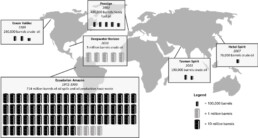
Notorious Oil Spills: When a tanker sinks or a rig close to the United States blows we hear a lot about it in the media, but none of the most notorious spills even come close to the amount of oil and toxic wastes that have been dumped into the Ecuadorian Amazon over the years.
For the past 50 years, the people living in the northern Ecuadorian Amazon have been the victims of countless spills and the irresponsible waste management practices of the companies extracting oil in the region. Between 1972 and 1993, 714 million barrels (or 30 billion gallons) of oil and toxic waste have been purposefully or accidentally released into the environment. While none of the individual spills measure up to the infamous spills named above, over the years they have added up to more than 140 times the 2010 BP Deepwater Horizon spill in the Gulf of Mexico. What’s more, this ‘slow-drip’ means that people are in near-constant contact with oil and waste products. Even less is known about the health impacts of this relentless contact with oil, but the short-term studies carried out on the large-scale spills can give us a clue as to what might be happening among indigenous peoples of the region.
Oil spill near the Kofán community of Avie.
Health impacts of oil spills
Published studies have looked at both self-reported symptoms and biomarkers (laboratory results from samples) in people who came into contact in some way with oil or gas following spills (Aguilera et al. 2010; D’Andrea and Reddy 2014; Laffon et al. 2016; for a recent review see Ramirez et al. 2017). Self-reported symptoms can be grouped into respiratory problems, irritations (eye, skin, etc.), neurological effects (headache, dizziness, etc.) and traumatic symptoms (pain). Symptoms were, in many cases, related to the intensity of the exposure. In other words, the closer the person was to the spill or the more time they spent near the spill, the greater the symptoms. These findings suggest that each time local Ecuadorian Amazonian people are exposed to a spill they suffer these same symptoms. The nonstop contact with oil among indigenous people in the northern Ecuadorian Amazon would presumably have a cumulative effect, making individuals more vulnerable once an accident occurs.
Self-reported skin rashes from contact with an oil spill.
Studies of biomarkers have uncovered irreparable harm to humans exposed to oil and gas from spills. These effects can be grouped into respiratory damage, liver damage, decreased immunity, increased cancer risk, reproductive damage and higher levels of some toxics (hydrocarbons and heavy metals).
The only study looking at Amazonian indigenous people’s health markers following a spill was carried out in the Peruvian Amazon four months after a localized spill (Webb et al. 2016). The study showed that men who had worked cleaning up the spill had twice as much mercury in their urine as did men who had not been involved in the effort to restore the lagoon in which the oil had stagnated. Mercury damages the brain and the liver. Each time a pipeline ruptures or a waste pit overflows, we could expect that the people in the vicinity are flooded with mercury, through their water, the fish they eat, and the air they breathe. Several other studies conducted in the Ecuadorian Amazon have linked proximity to oil operations with illness (such as cancer, skin irritations, etc.) (San Sebastian et al. 2001; 2004; Hurtig et al. 2004; Paz-y-Miño et al. 2008). While the studies were not linked to a specific spill, they were carried out in areas having borne numerous accidents. Two studies, both financially supported by Chevron, unsurprisingly, found no link between cancer and oil extraction (Kelsh et al. 2009; Moolgavkar et al. 2014).
Where do we go next?
The longest-term study ever carried out followed fishers six years after the Prestige oil spill off the coast of Spain and evaluated respiratory health effects. A clinical study looking at the effect of water from the Gulf of Mexico following the Deepwater Horizon oil spill found that human lung cells grown in the water, which contained both the spilled oil and oil dispersants, showed signs of damage, pointing to some of the ways in which oil and dispersants wreak havoc on the human body. From other clinical studies (on mice and cells) we know that one of the main health effects of hydrocarbons, the principal component of oil, is cancer. In order to capture cancer rates, studies need to run for an extended period of time. A longitudinal (long-term) study on the impacts of oil spills is needed.
What can you do?
Reducing the demand for oil is the best way that individual citizens can reduce the number of spills. In order to reduce your consumption, take public transportation, eat local, eat lower on the food chain (vegetarian), and consume less. You can also demand that your institutions (bank, school, municipality) divest from oil companies. Amazon Frontlines is working with the indigenous organization Ceibo Alliance to help indigenous people know what risks they face. Knowing the risks is the first step in being able to take action to defend indigenous rights to health and demand greater environmental protections in the Amazon. See the work of our Environmental Monitoring and contribute to this work here.
Reference list
- Aguilera F, Méndez J, Pásaro E, Laffon B (2010) Review on the effects of exposure to spilled oils on human health Journal of Applied Toxicology 30:291-301 doi:10.1002/jat.1521
- D’Andrea MA, Reddy GK (2014) Crude oil spill exposure and human health risks Journal of occupational and environmental medicine 56:1029-1041
- Hurtig A-K, San Sebastián M (2004) Incidence of Childhood Leukemia and Oil Exploitation in the Amazon Basin of Ecuador Int J Occup Environ Health 10:245-250
- Kelsh M, Morimoto L, Lau E (2009) Cancer mortality and oil production in the Amazon Region of Ecuador, 1990–2005 Int Arch Occup Environ Health 82:381-395
- Laffon B, Pásaro E, Valdiglesias V (2016) Effects of exposure to oil spills on human health: updated review Journal of Toxicology and Environmental Health, Part B 19:105-128
- Moolgavkar SH, Chang ET, Watson H, Lau EC (2014) Cancer mortality and quantitative oil production in the Amazon region of Ecuador, 1990–2010 Cancer Causes Control 25:59-72 doi:10.1007/s10552-013-0308-8
- Paz-y-Miño C, López-Cortés A, Arévalo M, Sánchez ME (2008) Monitoring of DNA Damage in Individuals Exposed to Petroleum Hydrocarbons in Ecuador Ann N Y Acad Sci 1140:121-128 doi:10.1196/annals.1454.013
- Ramirez MI, Arevalo AP, Sotomayor S, Bailon-Moscoso N (2017) Contamination by oil crude extraction – Refinement and their effects on human health Environmental Pollution 231:415-425 doi:https://doi.org/10.1016/j.envpol.2017.08.017
- San Sebastian M, Armstrong B, Cordoba JA, Stephens C (2001) Exposures and cancer incidence near oil fields in the Amazon basin of Ecuador Occupational & Environmental Medecine 58:517-522
- San Sebastian M, Hurtig AK (2004) Oil exploitation in the Amazon basin of Ecuador: a public health emergency Rev Panam Salud Publica 15:205-211
- Webb J, Coomes OT, Mergler D, Ross N (2016) Mercury Concentrations in Urine of Amerindian Populations Near Oil Fields in the Peruvian and Ecuadorian Amazon Environmental Research 151:344-350
List of chronicles in our Health on the Frontlines series:
Be a Champion for the Amazon!
Start a fundraising campaign to drive resources to Indigenous Earth Defenders on the frontlines


